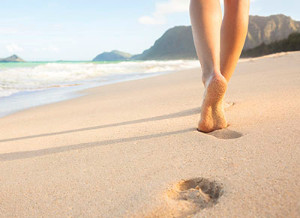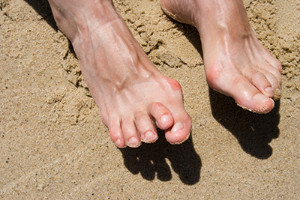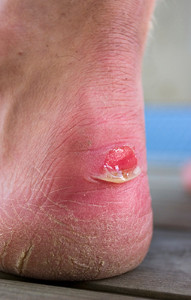
Drexel Hill (484) 521-0233
West Chester (610) 436-5883

Drexel Hill (484) 521-0233
West Chester (610) 436-5883
 Although Emilie Reas of San Diego loves to run, there is something about her running that makes her stand out from everyone else. Reas has been able to run different marathons all while being barefoot. After discovering in 2013 that barefoot running can reduce injuries, Reas has opted to stop wearing shoes when she competes. There is a difference in biomechanics between barefoot runners compared to runners who wear sneakers. People who wear sneakers are more likely to land on the heels of their feet when they step, while barefoot runners tend to land on their forefeet.
Although Emilie Reas of San Diego loves to run, there is something about her running that makes her stand out from everyone else. Reas has been able to run different marathons all while being barefoot. After discovering in 2013 that barefoot running can reduce injuries, Reas has opted to stop wearing shoes when she competes. There is a difference in biomechanics between barefoot runners compared to runners who wear sneakers. People who wear sneakers are more likely to land on the heels of their feet when they step, while barefoot runners tend to land on their forefeet.
Barefoot running has its own share of benefits and disadvantages. If you have any concerns about your feet or ankles, contact the podiatrists from Dr. Siegerman & Associates. Our doctors will treat your foot and ankle needs.
Barefoot Running
The Impact of Barefoot Running
The Advantages of Barefoot Running
The Drawbacks of Barefoot Running
So, what can runners do to make barefoot running safe? It’s best to make a slow transition from running shoes to barefoot running. Once the feet begin to adjust, try walking, then jogging and gradually increasing the distance. Minimalist running shoes may also be an option.
If you have any questions please feel free to contact one of one of our offices located in Drexel Hill and West Chester, PA . We offer the newest diagnostic and treatment technologies for all your foot and ankle needs.
 Hammertoe is a type of foot deformity that occurs when the toe begins to bend or buckle, and it is sometimes caused when the feet constantly rub against footwear, like high heels. Consequently, this condition is more commonly found in women compared to men. Laurie Keegan, a sufferer of hammertoe, has this to say about the condition: “I can't do the things I want to do. I get on the treadmill and I can only be on there for about 20 minutes. It's just too painful. I can't continue.” Fortunately, surgery can be done to repair hammertoe, but you should consult with your podiatrist before you begin to seek it as an option.
Hammertoe is a type of foot deformity that occurs when the toe begins to bend or buckle, and it is sometimes caused when the feet constantly rub against footwear, like high heels. Consequently, this condition is more commonly found in women compared to men. Laurie Keegan, a sufferer of hammertoe, has this to say about the condition: “I can't do the things I want to do. I get on the treadmill and I can only be on there for about 20 minutes. It's just too painful. I can't continue.” Fortunately, surgery can be done to repair hammertoe, but you should consult with your podiatrist before you begin to seek it as an option.
Hammertoe
Hammertoes can be a painful condition to live with. For more information, contact the podiatrists from Dr. Siegerman & Associates. Our doctors will answer any of your foot- and ankle-related questions.
Hammertoe is a foot deformity that affects the joints of the second, third, fourth, or fifth toes of your feet. It is a painful foot condition in which these toes curl and arch up, which can often lead to pain when wearing footwear.
Symptoms
Causes
Genetics – People who are genetically predisposed to hammertoe are often more susceptible
Arthritis – Because arthritis affects the joints in your toes, further deformities stemming from arthritis can occur
Trauma – Direct trauma to the toes could potentially lead to hammertoe
Ill-fitting shoes – Undue pressure on the front of the toes from ill-fitting shoes can potentially lead to the development of hammertoe
Treatment
Orthotics – Custom made inserts can be used to help relieve pressure placed on the toes and therefore relieve some of the pain associated with it
Medications – Oral medications such as anti-inflammatories or NSAIDs could be used to treat the pain and inflammation hammertoes causes. Injections of corticosteroids are also sometimes used
Surgery – In more severe cases where the hammertoes have become more rigid, foot surgery is a potential option
If you have any questions please contact one of our offices located in Drexel Hill and West Chester, PA . We offer the newest diagnostic and treatment technologies for all your foot and ankle needs.
 Although you may be excited to try on your brand new pair of shoes, you should be careful to avoid getting blisters while wearing them. Blisters are not only uncomfortable, but they often force you to walk in an unnatural way to compensate for the pain they cause. Fortunately, there are some tips you can follow to avoid getting blisters and having to deal with them while wearing your new kicks. One tip is to walk around in your new shoes at home prior to wearing them out in public. Wearing your shoes at home will help loosen them up so that the shoes are already broken-in when you are ready for regular use. Another tip is to make sure that you are wearing proper socks. While most people tend to wear ankle socks, they offer very little protection for your feet compared to longer ones. You should also make sure that the socks you wear are made up of a material that dries quickly. A material like cotton, which tends to stay damp for a while, may soften the skin and make you more susceptible to blisters.
Although you may be excited to try on your brand new pair of shoes, you should be careful to avoid getting blisters while wearing them. Blisters are not only uncomfortable, but they often force you to walk in an unnatural way to compensate for the pain they cause. Fortunately, there are some tips you can follow to avoid getting blisters and having to deal with them while wearing your new kicks. One tip is to walk around in your new shoes at home prior to wearing them out in public. Wearing your shoes at home will help loosen them up so that the shoes are already broken-in when you are ready for regular use. Another tip is to make sure that you are wearing proper socks. While most people tend to wear ankle socks, they offer very little protection for your feet compared to longer ones. You should also make sure that the socks you wear are made up of a material that dries quickly. A material like cotton, which tends to stay damp for a while, may soften the skin and make you more susceptible to blisters.
Blisters are prone to making everyday activities extremely uncomfortable. If your feet are hurting, contact the podiatrists of Dr. Siegerman & Associates. Our doctors can provide the care you need to keep you pain-free and on your feet.
Foot Blisters
Foot blisters develop as a result of constantly wearing tight or ill-fitting footwear. This happens due to the constant rubbing from the shoe, which can often lead to pain.
What Are Foot Blisters?
A foot blister is a small fluid-filled pocket that forms on the upper-most layer of the skin. Blisters are filled with clear fluid and can lead to blood drainage or pus if the area becomes infected.
How Do Blisters Form?
Blisters on the feet are often the result of constant friction of skin and material, usually by shoe rubbing. Walking in sandals, boots, or shoes that don’t fit properly for long periods of time can result in a blister. Having consistent foot moisture and humidity can easily lead to blister formation.
Prevention & Treatment
It is important to properly care for the affected area in order to prevent infection and ease the pain. Do not lance the blister and use a Band-Aid to provide pain relief. Also, be sure to keep your feet dry and wear proper fitting shoes. If you see blood or pus in a blister, seek assistance from a podiatrist.
If you have any questions, please feel free to contact one of our offices located in Drexel Hill and West Chester, PA . We offer the newest diagnostic and treatment technologies for all your foot care needs.
 The first step to getting into a proper running routine is to make sure you are wearing the right running shoes. The proper shoe will help to correct biomechanical issues and prevent injury. You should always go to a sneaker store that specializes in running shoes so that the workers can help you find a sneaker that fits your foot strike. There are three main types of runners based on foot strikes: overpronators (when the foot rolls inward too much), neutral pronators (feet roll inward slightly), and supinators (feet don’t roll inward enough). Certain running shoe stores will have you run on a treadmill so that the workers can best determine which shoe type will fit you properly. You will know the shoe is a good fit if you “feel like you want to go run immediately," said runner Dimity McDowell.
The first step to getting into a proper running routine is to make sure you are wearing the right running shoes. The proper shoe will help to correct biomechanical issues and prevent injury. You should always go to a sneaker store that specializes in running shoes so that the workers can help you find a sneaker that fits your foot strike. There are three main types of runners based on foot strikes: overpronators (when the foot rolls inward too much), neutral pronators (feet roll inward slightly), and supinators (feet don’t roll inward enough). Certain running shoe stores will have you run on a treadmill so that the workers can best determine which shoe type will fit you properly. You will know the shoe is a good fit if you “feel like you want to go run immediately," said runner Dimity McDowell.
If you are a runner, wearing the right running shoe is essential. For more information, contact the podiatrists from Dr. Siegerman & Associates. Our doctors can provide the care you need to keep you pain-free and on your feet.
Choosing the Right Running Shoe for Your Foot Type
To increase performance and avoid the risk of injury, it is important to choose the right running shoe based on your foot type. The general design of running shoes revolves around pronation, which is how the ankle rolls from outside to inside when the foot strikes the ground.
If you have any questions please feel free to contact one of our offices located in Drexel Hill and West Chester, PA . We offer the newest diagnostic and treatment technologies for all your foot and ankle needs.
Request a free copy of
Laser Away Foot Pain!
today.
